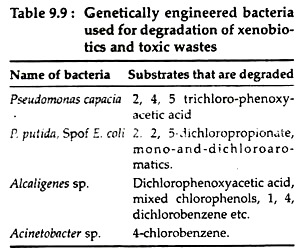The following points highlight the top four applications of genetic engineering in management of environment. The applications are: 1. Control of Oil Pollution 2. Control of Heavy Metal Pollution 3. Use of Bio-Pesticides 4. Removal of Xenobiotics and Toxic Wastes.
Application # 1. Control of Oil Pollution:
Oil spills from oil tankers either on water or water surfaces cause a major environmental hazard. Earlier use of chemical dispersants was shown to cause major pollution in shallow water due to their toxic nature and prolong persistence in the environment.
Various species of Pseudomonas have the property to consume available hydrocarbons from oil and can produce active surface compounds that can emulsify oil in water and thus facilitate easy removal of oil. Dr. Ananda Chakrobarty has engineered a strain of Pseudomonas aeruginosa which produces a glycolipid emulsifier that reduces the surface tension of an oil-water interface and thus helps in removal of oil from water.
Many such genetically engineered microbes can be used by mixing with straw, which then will be scattered over the spilled oil, the straw will first soak oily water and then the microbes will break up the oil into non-toxic, non-polluting substances, rendering the environment harmless.
Application # 2. Control of Heavy Metal Pollution:
ADVERTISEMENTS:
Integrated management of polluted ecosystem by the use of diverse kind of organisms which restore the natural process in the ecosystem is called bioremediation. Application of genetically engineered organisms, specially plants in bioremediation, to rid contaminated soil from heavy metal toxicity has proved encouraging.
Phytochelatins, a class of metallothioneins, proteins and peptides are metal-absorber in plants. Glutathione acts as the precursor for the production of phytochelatins. Plants grown in metal-toxic soils can trap the metals by proteins and peptides.
With the help of genetic engineering, poplar trees have been constructed with gene coding for the bacterial enzyme y-glutamylcysteine synthetase, the enzyme involved in glutathione synthesis.
Genetic engineering can also be applied to increase the ion transport capacity across the root cell plasma membrane of many plants. Many genes (e.g., Arabidopsis irt 1, copt 1 and zip genes) have been isolated to enhance the function of transporter complexes for specific target metal removal from soil.
ADVERTISEMENTS:
Over-expression of these ion transporter increases heavy metal uptake by transformed plants. Similarly, a modified bacterial Hg+ reductase gene has been inserted in plants to remove Hg toxicity by converting it into elemental form. In these ways, genetic engineering can restore fertility of contaminated soil.
Application # 3. Use of Bio-Pesticides:
In developing countries, about 60 to 70% of food, during harvesting and post-harvested period is lost on account of pests. Majority of chemical pesticides, herbicides and fertilisers cause numerous hazards, because these substances release various pollutants in the environment. To minimise the use of chemicals and pesticides, bio-pesticides are being used.
These are compounds derived from natural biological sources like animals, plants; bacteria and can limit the growth of pests. For example, plant-incorporated protectants (PIPs) are bio-pesticides produced by plants through genetic manipulation.
Strains of Bacillus thuringiensis, Bt can produce protein which kills specific species of insect larvae. Genes of Bt pesticide protein can be transformed into other plants like tobacco, cotton, tomato etc.
ADVERTISEMENTS:
These genetically transformed plants can express the gene by producing protein pesticide while growing and can be protected from pest attack. Such bio-pesticides are less toxic and are biodegradable. Consequently these do not pose any problem of bioaccumulation and bio-magnification as found in case of broad spectrum chemical pesticides.
Application # 4. Removal of Xenobiotics and Toxic Wastes:
Xenobiotics are wastes released from non-biological systems. Xenobiotics and many other toxic wastes can be removed from environment by bacteria that are modified genetically. For this purpose, genes are isolated from bacteria found at waste sites, which are themselves not very efficient degraders.
Therefore, multiple genes may sometimes be required for efficient biodegrading of the wastes. Some of the genetically engineered bacterial strains used in bio- degradation of waste materials are given in Table 9.9.
